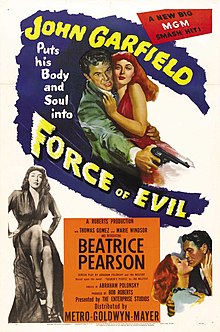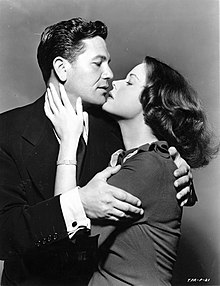| Force of Evil | |
|---|---|
 Theatrical release poster | |
| Directed by | Abraham Polonsky |
| Screenplay by | Abraham Polonsky Ira Wolfert |
| Based on | Tucker's People 1943 novel by Ira Wolfert |
| Produced by | Bob Roberts |
| Starring |
John Garfield Thomas Gomez Marie Windsor Beatrice Pearson |
| Cinematography | George Barnes |
| Edited by | Art Seid |
| Music by | David Raksin |
Production company | |
| Distributed by | Metro-Goldwyn-Mayer |
Release date |
|
Running time | 76 minutes |
| Country | United States |
| Language | English |
| Budget | $1,150,000 [1] |
| Box office | $1,165,000 [2] |
Force of Evil is a 1948 American crime film noir starring John Garfield and directed by Abraham Polonsky. It was adapted by Polonsky and Ira Wolfert from Wolfert's novel Tucker's People. [3] Polonsky had been a screenwriter for the boxing film Body and Soul (1947), in which Garfield had also played the male lead.
In 1994, Force of Evil was selected for preservation in the United States National Film Registry by the Library of Congress as being "culturally, historically, or aesthetically significant". [4] [5]
Plot

Lawyer Joe Morse (Garfield) works for a powerful gangster, Tucker, who wishes to consolidate and control the numbers racket in New York City. This requires absorbing many smaller outfits, one of which is run by Morse's older brother Leo ( Thomas Gomez). One relishes his life in the underworld, the other is disgusted by it and seeks to minimize its impact. Even seeking to soften things for Leo things go wrong for Joe, and tragedy befalls both.
The terse, melodramatic thriller incorporates realist location photography, almost poetic dialogue and biblical allusions to Cain and Abel and Judas's betrayal.
Cast
- John Garfield as Joe Morse
- Beatrice Pearson as Doris Lowry
- Thomas Gomez as Leo Morse
- Marie Windsor as Edna Tucker
- Howland Chamberlain as Frederick "Freddie" Bauer
- Roy Roberts as Ben Tucker
- Paul Fix as Bill Ficco
- Stanley Prager as Wally
- Barry Kelley as Det. Egan
- Beau Bridges as Frankie Tucker
Reception
Critical response
When the film was released, the staff at Variety magazine gave the film a mixed review, praising its production values but panning its focus and "intrusively" flowery language:
Force of Evil fails to develop the excitement hinted at in the title. Makers apparently couldn't decide on the best way to present an exposé of the numbers racket, winding up with neither fish nor fowl as far as hard-hitting racketeer meller is concerned. A poetic, almost allegorical, interpretation keeps intruding on the tougher elements of the plot. This factor adds no distinction and only makes the going tougher ... Garfield, as to be expected, comes through with a performance that gets everything out of the material furnished ... On the technical side, the production fares better than story-wise. The physical mounting is expertly valued; the New York locale shots give authenticity; and lensing by George Barnes, while a bit on the arty side, displays skilled craftsmanship. [6]
Bosley Crowther, the film critic for The New York Times, liked the film, and wrote, "But for all its unpleasant nature, it must be said that this film is a dynamic crime-and-punishment drama, brilliantly and broadly realized. Out of material and ideas that have been worked over time after time, so that they've long since become stale and hackneyed, it gathers suspense and dread, a genuine feeling of the bleakness of crime and a terrible sense of doom. And it catches in eloquent tatters of on-the-wing dialogue moving intimations of the pathos of hopeful lives gone wrong." [7]
Wrote film historian Andrew Sarris in 1968, "Force of Evil stands up under repeated viewings as one of the great films of the modern American cinema and Garfield's taxicab scene with Beatrice Pearson takes away some of the luster Kazan's Brando- Steiger tour de force in On the Waterfront." [8]
In the decades since its release Force of Evil has been recognized by some as a high point of the film noir genre, powerful in its poetic images and language, by such film critics and historians such as William S. Pechter and Andrew Dickos.[ citation needed] Its influence has been acknowledged many times by Martin Scorsese in the making of his crime dramas.[ citation needed]
Box-office
According to MGM records the film earned $948,000 in the US and $217,000 overseas. [2]
Accolades
American Film Institute Lists
- AFI's 100 Years ... 100 Movies - Nominated [9]
- AFI's 10 Top 10 - Nominated Gangster Film [10]
- AFI's 100 Years ... 100 Movies (10th Anniversary Edition) - Nominated [11]
Preservation
Force of Evil was preserved and restored by the UCLA Film and Television Archive. Restoration provided by The Packard Humanities Institute. The restoration premiered at the UCLA Festival of Preservation in 2022.
References
- ^ "Inside Stuff - Pictures". Variety. 10 November 1948. p. 22.
- ^ a b The Eddie Mannix Ledger, Los Angeles: Margaret Herrick Library, Center for Motion Picture Study.
- ^ Force of Evil at the American Film Institute Catalog.
- ^ "25 Films Added to National Registry". The New York Times. 1994-11-15. ISSN 0362-4331. Retrieved 2020-10-02.
- ^ "Complete National Film Registry Listing". Library of Congress. Retrieved 2020-10-02.
- ^ Variety. Staff film review, December 25, 1948. Accessed: February 11, 2010."
- ^ Crowther, Bosley. The New York Times, film review, December 27, 1948. Accessed: February 11, 2010.
- ^ Sarris, Andrew. 1968. The American Cinema: Directors and Directions, 1929-1968. E.P. Dutton & Co. New York. p. 220
- ^ "AFI's 100 Years...100 Movies Nominees" (PDF). Archived from the original (PDF) on 2013-10-26. Retrieved 2011-07-01.
- ^ "AFI's 10 Top 10 Ballot" (PDF). Archived from the original (PDF) on 2017-03-26. Retrieved 2011-07-01.
- ^ AFI's 100 Years...100 Movies (10th Anniversary Edition) Nominees
External links
- Force of Evil is available for free viewing and download at the Internet Archive
- Force of Evil at the American Film Institute Catalog
- Force of Evil at IMDb
- Force of Evil at Rotten Tomatoes
- Force of Evil at AllMovie
- Force of Evil at the TCM Movie Database
- Force of Evil analysis of film by Sydney Pollack at Turner Classic Movies
- Force of Evil scene on YouTube
- Force of Evil essay by Daniel Eagan in America's Film Legacy: The Authoritative Guide to the Landmark Movies in the National Film Registry, A&C Black, 2010 ISBN 0826429777, pages 421-423 [1]
- 1948 films
- 1948 crime drama films
- American crime drama films
- American black-and-white films
- 1940s English-language films
- Film noir
- Films set in New York City
- Films about gambling
- Metro-Goldwyn-Mayer films
- United States National Film Registry films
- Films shot in Fort Lee, New Jersey
- Films shot in New York City
- Films scored by David Raksin
- 1940s American films